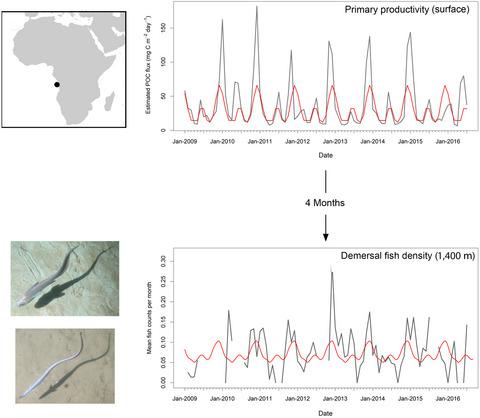当前位置:
X-MOL 学术
›
J. Anim. Ecol.
›
论文详情
Our official English website, www.x-mol.net, welcomes your feedback! (Note: you will need to create a separate account there.)
Evidence for seasonal cycles in deep-sea fish abundances: a great migration in the deep SE Atlantic?
Journal of Animal Ecology ( IF 4.8 ) Pub Date : 2020-04-11 , DOI: 10.1111/1365-2656.13215 Rosanna J Milligan 1, 2 , E Marian Scott 3 , Daniel O B Jones 4 , Brian J Bett 4 , Alan J Jamieson 5 , Robert O'Brien 6 , Sofia Pereira Costa 7 , Gilbert T Rowe 8 , Henry A Ruhl 4, 9 , Ken L Smith 9 , Philippe de Susanne 7 , Michael F Vardaro 10 , David M Bailey 1
Journal of Animal Ecology ( IF 4.8 ) Pub Date : 2020-04-11 , DOI: 10.1111/1365-2656.13215 Rosanna J Milligan 1, 2 , E Marian Scott 3 , Daniel O B Jones 4 , Brian J Bett 4 , Alan J Jamieson 5 , Robert O'Brien 6 , Sofia Pereira Costa 7 , Gilbert T Rowe 8 , Henry A Ruhl 4, 9 , Ken L Smith 9 , Philippe de Susanne 7 , Michael F Vardaro 10 , David M Bailey 1
Affiliation

|
Animal migrations are of global ecological significance, providing mechanisms for the transport of nutrients and energy between distant locations. In much of the deep sea (> 200 m water depth) the export of nutrients from the surface ocean provides a crucial but seasonally-variable energy source to seafloor ecosystems. Seasonal faunal migrations have been hypothesised to occur on the deep seafloor as a result, but have not been documented. Here, we analyse a 7.5-year record of photographic data from the DELOS seafloor observatories to determine whether there was evidence of seasonal (intra-annual) migratory behaviours in a deep-sea fish assemblage on the West African margin and, if so, identify potential cues for the behaviour. Our findings demonstrate a correlation between intra-annual changes in demersal fish abundance at 1400 m depth and satellite-derived estimates of primary production off the coast of Angola. Highest fish abundances were observed in late November with a smaller peak in June, occurring approximately four months after corresponding peaks in primary production. Observed changes in fish abundance occurred too rapidly to be explained by recruitment or mortality, and must therefore have a behavioural driver. Given the recurrent patterns observed, and the established importance of bottom-up trophic structuring in deep-sea ecosystems, we hypothesize that a large fraction of the fish assemblage may conduct seasonal migrations in this region, and propose seasonal variability in surface ocean primary production as a plausible cause. Such trophic control could lead to changes in the abundance of fishes across the seafloor by affecting secondary production of prey species and/or carrion availability for example. In summary, we present the first evidence for seasonally-recurring patterns in deep-sea demersal fish abundances over a seven-year period, and demonstrate a previously unobserved level of dynamism in the deep sea, potentially mirroring the great migrations so well characterized in terrestrial systems.
中文翻译:

深海鱼类丰度季节性周期的证据:东南大西洋深处的大迁徙?
动物迁徙具有全球生态意义,为遥远地区之间的营养和能量运输提供了机制。在大部分深海(> 200 m 水深)中,来自表层海洋的营养物质的输出为海底生态系统提供了关键但随季节变化的能源。季节性动物迁徙被假设因此发生在深海海底,但尚未记录在案。在这里,我们分析了来自 DELOS 海底天文台的 7.5 年摄影数据记录,以确定是否有证据表明西非边缘的深海鱼类群落有季节性(年内)洄游行为,如果有,确定行为的潜在线索。我们的研究结果表明,1400 m 深度底栖鱼类丰度的年内变化与安哥拉沿海初级生产的卫星衍生估计之间存在相关性。在 11 月下旬观察到最高的鱼类丰度,在 6 月出现较小的峰值,发生在初级生产的相应峰值之后大约四个月。观察到的鱼类丰度变化发生得太快,无法用补充或死亡率来解释,因此必须有一个行为驱动因素。鉴于观察到的重复模式,以及深海生态系统中自下而上的营养结构的重要性,我们假设大部分鱼类组合可能在该地区进行季节性迁移,并提出表层海洋初级生产的季节性变化为一个合理的原因。例如,通过影响猎物物种的二次生产和/或腐肉的可用性,这种营养控制可能导致海底鱼类丰度的变化。总而言之,我们提供了第一个关于七年期间深海底层鱼类丰度季节性反复模式的证据,并证明了深海中以前未观察到的动态水平,可能反映了陆地上的大迁徙。系统。
更新日期:2020-04-11
中文翻译:

深海鱼类丰度季节性周期的证据:东南大西洋深处的大迁徙?
动物迁徙具有全球生态意义,为遥远地区之间的营养和能量运输提供了机制。在大部分深海(> 200 m 水深)中,来自表层海洋的营养物质的输出为海底生态系统提供了关键但随季节变化的能源。季节性动物迁徙被假设因此发生在深海海底,但尚未记录在案。在这里,我们分析了来自 DELOS 海底天文台的 7.5 年摄影数据记录,以确定是否有证据表明西非边缘的深海鱼类群落有季节性(年内)洄游行为,如果有,确定行为的潜在线索。我们的研究结果表明,1400 m 深度底栖鱼类丰度的年内变化与安哥拉沿海初级生产的卫星衍生估计之间存在相关性。在 11 月下旬观察到最高的鱼类丰度,在 6 月出现较小的峰值,发生在初级生产的相应峰值之后大约四个月。观察到的鱼类丰度变化发生得太快,无法用补充或死亡率来解释,因此必须有一个行为驱动因素。鉴于观察到的重复模式,以及深海生态系统中自下而上的营养结构的重要性,我们假设大部分鱼类组合可能在该地区进行季节性迁移,并提出表层海洋初级生产的季节性变化为一个合理的原因。例如,通过影响猎物物种的二次生产和/或腐肉的可用性,这种营养控制可能导致海底鱼类丰度的变化。总而言之,我们提供了第一个关于七年期间深海底层鱼类丰度季节性反复模式的证据,并证明了深海中以前未观察到的动态水平,可能反映了陆地上的大迁徙。系统。



























 京公网安备 11010802027423号
京公网安备 11010802027423号